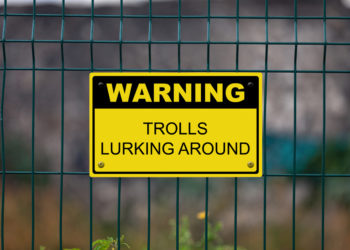What is no good for the hive is no good for the bee. — Marcus Aurelius, Meditations
One of the most interesting and perilous periods in the history that unites publishing, journalism, information, scholarship, technology, epistemology, and science is occurring right now. We are getting a master’s class in a typically remote patch of obfuscation, diversion, and shady vocabulary, from “fake news” to “collusion” to “cyber” to “covfefe.” This all has become something of great interest to me, and I’ve spent the bulk of the past months writing about it. Each incident and trend seems worthy of exploration and cogitation.

Underlying many of our information maladies is the abundance of information, facilitated by new technologies to be harder to manage and resist than ever. We’ll call it “abundance” to be nice, but it’s really a dizzying onslaught at this point, one that is harder and harder to escape. This so-called abundance requires information to be accessible, otherwise the abundance is merely theoretical. Information that is easily called to hand naturally supports business models that allow the information to be free (no financial cost) at the point of use. So we have free wi-fi, free news, and free feeds of opinions and headlines. This combination of “free” and ubiquitous information has changed the world.
Change is not always positive.
While our own initiatives to increase access (OA publishing, delayed free access, and so forth) have played some role in increased access, the rise in mobile computing, seen in the 2017 update on Internet Trends from Mary Meeker, suggests that the smartphone has been the most significant revolution in information access. In 2010, adults were spending about 40 minutes per day with digital media on their mobiles; now, they spend 3.1 hours per day, an increase of 4x. Overall, time spent with digital media has increased since 2010 from 3.2 hours per day to 5.6 hours per day, with all of the increase caused by increased information access via mobile devices. Since 2007, 2 billion smartphones have come into use.
In India, according to this same report, people spend per week two hours with print, four hours with television, and 28 hours peering into their mobile devices. Mobile is 82% of their time with media.
Mobile is central to social media. Facebook’s app is on 85% of all smartphones worldwide, and accounts for more than 65% of Facebook’s traffic in the US. The network effects may be innately anticompetitive, economists are beginning to think, with some worrying that the dominance of Google (Maps, search), Amazon (shopping), and Facebook (social) — increasingly via mobile devices — is contributing to economic slowdowns, wage gaps, and job stagnation. Economists’ concerns include worries about stifled innovation by entrepreneurs, who can be stymied by the power of these and their reach. The advertising business model adds to the anti-competitive puzzle, according to a recent article in BusinessWeek:
They don’t engage in the predatory behavior of yore, such as selling goods below the cost of production to steal market share and cripple competitors. After all, the services that Facebook and Google offer are free (if you don’t consider giving up your personal data and privacy rights to be a cost). However, academics have documented how these companies employ far fewer people than the largest companies of decades past while taking a disproportionate share of national profits. . . . Google and Facebook Inc. together control about 56 percent of the mobile ad market. . . . [one expert] pegs Facebook’s share of mobile social media traffic, including the company’s WhatsApp, Messenger, and Instagram units, at 75 percent.
For users, the information on mobile devices has many sources — emails, texts, social media, news, data apps, photos, sports, trivia, games. Via the smartphone, the entire information world has been blended down into a smoothie in which the various ingredients are harder to identify at the end of the day. Where did I hear that? Why do I now think that? What was that story again?
In some ways, the infrastructure of mobile pushes to make all information equal — equally shareable, equally formatted, and equally interesting. And because it passes by us equally quickly and with equal superficiality, the blender’s whir follows us throughout the day, macerating sources, facts, and headlines into an indistinct swirl. Even making a site responsive so that it reformats well on mobile devices means making compromises and choices, often dropping or suppressing functionality or detailed information. When the simplicity assumptions of mobile return to desktop design, the compromises in detail and fidelity can become the new normal. (Perhaps the PDF is still valued because it’s more detailed and less subject to design trends.)
This all has fed into a persistent false equivalency of information, as branding, in-depth reading, and temporal relationships all smudge away with flicks, gestures, likes, and shares. Given how superficial information and our familiarity with it has modified our critical faculties and attention spans, it’s not terribly surprising to read that spreading misinformation via social media, which is largely consumed now on mobile devices, is becoming standard practice for many governments around the world. We’re almost to the point where information has become like studies about nutrition — we wait for more information, leaving our views malleable. This has major implications.
We want to believe that whoever is paying for the information we enjoy is equally if only indirectly committed to the information’s quality, veracity, and accuracy
Underneath it all are the business models. It’s here where free information’s gets its power — from advertisers, sponsors, and the like. These models, sourced from producers rather than consumers, are easier to exploit and more prone to conflicts of interest, as I’ve written about before. We want to believe that whoever is paying for the information we enjoy is equally if only indirectly committed to the information’s quality, veracity, and accuracy — or that we’re able to tell when they are not. This is not necessarily the case. Most social media and mobile-enabled business models are committed to clicks, traversals, and advertising. This means mini-information that requires continued browsing (listicles and the like), and smaller, more superficial items that lead to deeper content. Having so much information at hand spreads out the sources, so there aren’t many single sources to justify a subscription. This leaves advertising, information arbitrage, and sponsorship as the other options. These weaker business models proliferate on mobile devices, especially around proven information sources.
There are important values-laden incentives within the various business models — individual subscription, site licensing, Green OA, Gold OA, advertising, and sponsorship. The business models are not equivalent in their effect or incentives.
This recently came up in an essay by Richard Poynder about what he sees as the prevalence of sponsorship driving the information landscape. While some of his assertions struck me as a bit of a reach (e.g., I don’t think publishers were secretly sponsoring meetings and lobbying to drive OA acceptance), the meta-argument that business models have consequences and can’t be viewed as equivalent is important:
. . . more and more content is being funded by the producers rather than the readers. This has a number of consequences. Above all, it has made it increasingly difficult to distinguish neutral information and reporting from partisan content created solely to serve the interests of the creator/sponsor.
As the subscription model has been sidelined and shamed in scholarly publishing (it is flourishing nearly everywhere else, it seems — from Amazon Prime to Netflix to box services), there has been a rise in sponsored content in many scientific settings, in addition to OA and other non-subscription revenue approaches that depend on producers paying. There is a reluctance to even pursue subscriptions, as if asking people to pay for something of value is dirty or embarrassing. As Poynder writes:
. . . the widespread view that paywalls and subscriptions are not acceptable in an online world. The implications of this are considerable.
These implications can be especially insidious on social platforms and mobile devices, where information loses a lot of provenance. A recent study found that more than half of the hematologist-oncologists using Twitter have a conflict of interest that they cannot or do not disclose via the platform. The information may be good or bad, but what the user possesses is incomplete. The device inhibits presentation or scrutiny of the information, and because the producer has paid for the information to be purveyed, there is no incentive to improve things for the user.
Producer-funded publications are not new. Sponsored journal supplements have been around for decades. The sponsorship information was easily discerned, and supplements were easily identified as information readers needed to take as preliminary or flattering to the sponsor. But the sophistication and integration of these new content sponsorships have increased significantly, even as the user’s ability to detect the sponsor or funder has diminished. Think of how subtle the “Promoted” link in Twitter has become. Or that sponsored section in Nature. Or the sponsored microsite.
Then, reflect on how if the subscription model were working better, your business might change its policies on accepting sponsorships or building sponsored microsites. The business model drives editorial choices, just as in OA publishing it tends to drive the market toward higher throughput.
Ultimately, the reliance on producer-side funding models led by Silicon Valley, their disciples, and our received wisdom about mobile and Millennials has been caused by a lack of commitment to the inherent values superiority of the subscription model. We can find counter-examples all around us. HBO can stand being sued by a coal CEO who allegedly was inspired by a conversation with a squirrel. Netflix can afford to pivot their entire infrastructure and model from mail-order DVDs of other people’s content to streaming original content. Amazon can have Prime Day for their Prime subscribers, creating a subscription-based quasi-holiday. There are now more than 5 billion mobile subscriptions in the world — paying for the underlying service. You’ll notice not one of these has anything to do with print.
The subscription model is not dead outside of publishing. In fact, subscriptions to newspapers surged when people began to worry about “fake news.” Millennials are even paying for subscriptions to news services. Now, the majority of Americans say they are paying for their news, either via print or online subscriptions (or some combination of the two). If you add in those using a free source who might consider paying for it, you’re talking about 4 out of 5 Americans who are paying for, or considering paying for, news. Magazines and newspapers lead the news sources benefiting from these subscription dollars.
Readers and users understand that paying for information means getting better information. The subscription model aligns the interests of producers and consumers of information better than any model available. Are we prepared to rationally consider the pros and cons of the various business models in the Digital Age?
Discussion
20 Thoughts on "Trouble at Hand — How Mobile Devices Perpetuate Weak Business Models"
Newspapers do not remain afloat from subscriptions. I can recall twenty years ago when 50 percent came from classified (decimated now by Craigslist and others) and 40 percent came from display ads, mostly large department stores (now reeling) and auto dealers (briefly in notable decline). Readership might rise but subscriptions won’t keep the lights on. Subscriptions are another anachronism of modern life.
The 1 million subscriptions at the New York Times do keep them afloat. A large and loyal subscriber base attracts advertisers, so advertising is actually more dependent on subscriptions than the reverse. In fact, the Times is looking to make more of its offerings paid via subscription. https://www.poynter.org/2017/digital-may-be-the-future-but-print-still-looms-large-in-the-present-fortunes-of-newspapers/467548/
I don’t know how you can assert subscriptions are anachronistic when they are more common and successful than ever, across information, service, and hard goods businesses alike (subscribing to food nowadays, for instance).
The Washington Post reports a booming subscription business as well:
http://www.npr.org/sections/alltechconsidered/2017/06/13/531099577/at-washington-post-tech-is-increasingly-boosting-financial-performance
More on the NY Times here:
http://money.cnn.com/2017/05/03/media/new-york-times-subscriber-growth/index.html
It’s hard to say though, how much of this growth is a reaction to Trump and how much is (as is being seen for other media like music and movies) a true consumer movement to subscription models for online content.
One point on this though. Most of those Washington Post subscriptions are around $25-40 and are from around the world. In the olden days that would be $85+ per year, be directly tied to a specific region (which was attractive to local advertisers) and hence be more valuable.
I’m not knocking subscriptions, on the contrary, I think its the only avenue of growth media currently has, but its less money, and more work to obtain than in the past. Plus only a few places can really pull it off.
Another interesting perspective on the interesting times in which we live. Our increasing limited attention span combined with superficial and mis-information offerings are certainly already a problem – and I am also concerned that this is going to get worse. However, I do not see the parallel between paying for a well-researched article from an investigative journalist and the communicating of own (publically funded) research results by a scientist. I agree there are issues with how some business models in OA are set up – but with higher transparency and awareness none should be insurmountable. In any case the serials crisis was born in the subscription era. In terms of the quality of reporting of research results in science, the main problems are independent of business models: for example, the lack of standards for reporting data, bad uses of statistical methods, the pressure to publish, and the fixation with publishing positive results.
The notion that all this research is publicly funded may need to be updated. For instance, in the US, 2/3 of R&D is funded by businesses. The government only funds 1/4. Funding from business is growing far faster than funding from governmental sources. It has been this way since the mid-1980s in the US. https://www.nsf.gov/statistics/2016/nsb20161/
The serials crisis has multiple causes, including stingy university budgets that place sporting facilities over academic and research success. In addition, the increased volume of research outputs, too many trained researchers competing for too few academic positions, the shopping mall model of academic life, etc., as you note, all have created a difficult set of trade-offs and pressures. These are not independent of business model, however, as a business model has to support the outputs that create the pressure valves for research reporting, which we do want (or else we have secrecy). The OA model has served to some extent as a pressure valve, and pre-prints are serving as another pressure valve. To be sustainable, they each need a business model.
The pressures these relieve, however, are producer-side pressures, not reader-side pressures. Readers want less information of higher quality. That’s been well-documented a number of times. I think one main point is who the business model is serving. If it’s not serving the reader, then the reader/editor/author alignment is incomplete.
There is also a significant portion of research (including entire fields) which is not funded at all.
Thanks for the link to the NIH report. By research I was referring to academic – apologies for not being precise. From the report, basic research is mainly funded by university and government, and business research investment has been decreasing since 2008. Business has more or less withdrawn from publishing research – at least in chemistry. I don’t think that one can say that OA and preprints are pressure-valves. They are the first stages of research communication starting to catch up with the rest of the world. However, the workflows and informatics are still in the 1980s. Research communication, if regarded as a common good, does not need a business plan in the sense of a commercial business. Maximizing profits should not be the aim – maximizing service should. I absolutely agree that more funds should be made available for communicating research – but the emphasis should be on quality not quantity, on content not metrics. As long as scientists are given targets to meet in terms of numbers of publications (and in which journals) and positive results, instead of insights the problems will remain.
“If you want better, more reproducible papers, you’re going to have fewer of them. Shorter publication lists, fewer journals, and especially fewer lower-tier journals.” — Derek Lowe, In the Pipeline. (http://blogs.sciencemag.org/pipeline/archives/2015/09/02/thoughts-on-reproducibility)
Profits (or surpluses) are an imperative for businesses and organizations, especially as having a cushion and market power help ensure independent decision-making.
We agree on some things, and I expect that we can agree to disagree on the others. In any event I would like to express my appreciation and respect that you and your fellow travelers have set up this wonderful blog. Actually I don’t think really is a blog because the quality is too high. Of course I am particularly pleased that it is open and free! For me the Scholarly Kitchen is exemplary for the scientific and democratic exchange of thoughts and ideas, which is precisely that which is missing on many other platforms and in the mobile world in which we find ourselves. Chapeau!
In terms of the quality of reporting of research results in science, the main problems are independent of business models: for example, the lack of standards for reporting data, bad uses of statistical methods, the pressure to publish, and the fixation with publishing positive results.
I agree that more emphasis should be put on high standards for published works. But this puts increased financial pressure on those upholding those standards, which seems to run into trouble with current OA business models. There are costs in checking articles for compliance, hiring a statistical editor, etc. These must be paid for, but there seems a market limit on APCs, and those journals that do significant levels of review and have high rejection rates (eLife, PLOS’ high end journals) run at a loss. Incurring these extra costs must be paid for somehow, and if current OA models are to do so, then that cost is concentrated on the author.
One of the benefits of the subscription model is that if you create a high quality product that is in high demand, costs can be spread broadly among a large body of readers, rather than concentrated on one author. A high end humanities journal I’ve worked with in the past charges the largest institutions around $300 per year to subscribe, but if they went fully OA would need to charge authors $18K each as an example.
It’s an interesting question, Kent – not just whether we are willing to consider the pros and cons of alternative business models, but once we do, how do we provide the value required to sustain a new model? Here, I am thinking about the value of providing a service (e.g., Amazon Prime’s 2-day shipping coupled with the vast selection of goods), or valued content (DIRECTV’s NFL Sunday Ticket; HBO and Netflix’s original movies and series) or information (newspaper and magazine articles) that cannot be gained by any other means. One striking commonality about the models for these products and services is that they rest on individual subscriptions, the pursuit of which most scholarly publishers (with well-considered reason) have been loath to pursue. Another commonality is exclusive provision. Even if publishers were to more actively market personal, digital subscriptions, in the age of SciHub, when the customers for our “product” can digitally obtain most of what we provide at no cost, it seems that a great deal more than content will need to be provided in order for the value proposition to hold. I am reminded here of the old sales adage: “Know your customer!” Any consideration of a new, digitally focused, business model would need, as a starting point, to identify who the customer is and what they want or need that is not presently provided elsewhere to their full satisfaction. If we are willing to look beyond the institutional subscription model and consider what additional services would add the necessary value for an alternative customer base actually making the purchase, it will be interesting, indeed, to see what models emerge.
This concern you raise has been keeping me awake for a while. How can you persuade individuals that your high quality content is worth paying for? Its easy with the hard core readers but they only make up 15% (tops) of your readership. Its the other 85% who casually buy a subscription that keep you afloat. Everyone always thought that it would be great being able to get news from everywhere without considering the bigger issue: being drowned out by competing or low quality content.
Plus it seems every two years or so something tries re-inventing the newspaper and fails.
One point to consider is that readers of scientific materials, seek the materials as they are available. Often those materials are scattered across many journals. Journals with a specific focus may have only a few articles of interest to individuals in that field. Preprints and similar streamed materials enhance the opportunity to pick across the body of knowledge. Smart phones and similar scavenging by intelligent bots that scrape the internet increasingly allow for such selective practices. Compiling of articles into a journal are more archival and historic in practice given the demand for immediacy.
We go back to the pre journal days where scholars exchanged information between interested parties. Current trends seem to be pointing to that direction. The fact that major publishers keep issuing more specialized journals is a reaction to the disruption that this post well points out.
There has always been a strange relationship between emerging scientific disciplines and the journals that publish results. The trend is to get more niche. Do fields establish journals? Or do journals establish fields? It’s a little bit of both, either, and neither in many cases.
But your assertion that there is a “demand for immediacy” is, I think, a producer-driven perspective — there is a demand for quick publication, which is part of the pressure that pre-prints alleviate. Readers have less demand for immediacy, as the continued success of review journals, review articles, and perspectives/editorials attest. It’s only when readers are becoming authors that they seem to get concerns about immediacy. In most fields, the threshold for acceptability usually takes multiple reinforcing studies and years, if not decades, to emerge. With producer-paid models, the reader-oriented editorial features also may suffer from a lack of attention and support.
immediacy might be the wrong word. But being able to search title, abstract, text and references with increasingly available systems for scraping across such materials, basically reduces the time and cost of waiting for a compiled “journal”, all other factors being equal. In this case, “immediacy” would mean the time saved in wading through the persiflage and separating false, weak or irrelevant materials for an individual’s needs of the moment.
I am in agreement that pub/perish and inherent related factors has an urgency particularly as the number of tenure track faculty positions can push academics into the precariat. I would suggest that his is to whom the proliferation of journals cater, increasing the pressure to seek ways through that proliferation. It supports the idea that compilation in journal format may need reassessment from a business perspective.
So who is driving this. We have left the scientific method of Bacon. The old adage “follow the money” points the finger clearly in one direction. But is everything so simple? What do you think the future of preprint servers will be? At moment they are not monetized.
There’s also this paper which is doing the rounds on social media this morning that suggests citations and facebook popularity follow the same curve. Which is a problem because facebook shares are usually based on what you think your friends are interested in, while you hope citations would be based on what is most interesting and unique.
http://journals.plos.org/plosone/article?id=10.1371%2Fjournal.pone.0179656
“The distribution of scientific citations for publications selected with different rules (author, topic, institution, country, journal, etc…) collapse on a single curve if one plots the citations relative to their mean value. We find that the distribution of “shares” for the Facebook posts rescale in the same manner to the very same curve with scientific citations. This finding suggests that citations are subjected to the same growth mechanism with Facebook popularity measures, being influenced by a statistically similar social environment and selection mechanism. In a simple master-equation approach the exponential growth of the number of publications and a preferential selection mechanism leads to a Tsallis-Pareto distribution offering an excellent description for the observed statistics. Based on our model and on the data derived from PubMed we predict that according to the present trend the average citations per scientific publications exponentially relaxes to about 4.”
This isn’t surprising, given the long history of awareness leading to citations. Other authors have to be aware of a paper’s existence to cite it, so the tool that best creates awareness will likely drive citations. Back in the late-1970s, the New England Journal of Medicine saw its citations go down when the New York Times stopped publishing during a newspaper strike. The papers published during the strike had stunted citations, because back then, the NYT was the main source driving awareness of NEJM papers. (http://www.nejm.org/doi/full/10.1056/NEJM199110173251620)
Now, the amplifier is social media.



